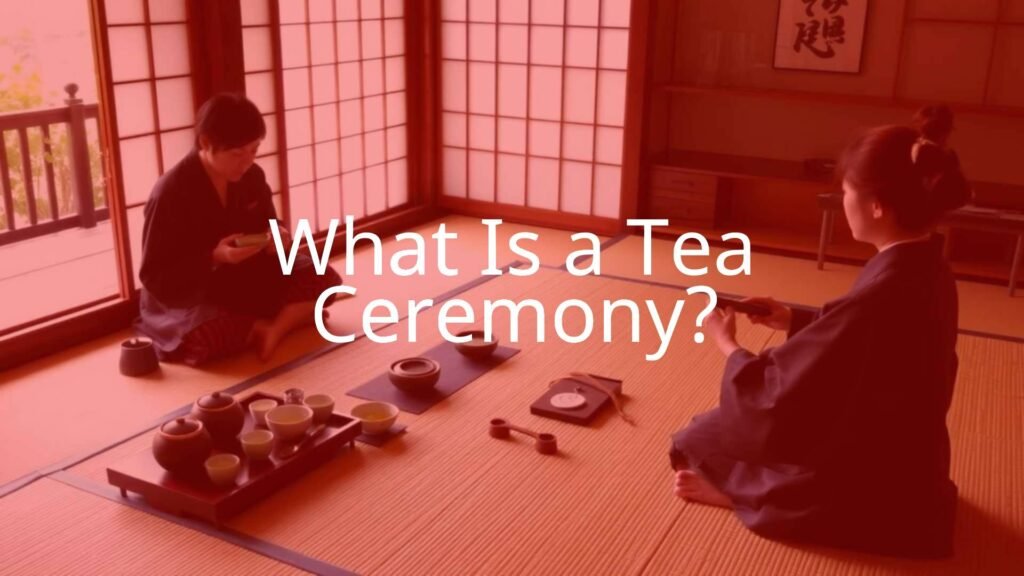A tea ceremony, especially the well-known Japanese version (called chanoyu, sadō, or chadō-all meaning “the way of tea”), is much more than just making and drinking tea. It is a carefully practiced tradition where serving tea becomes a special, structured event. Every action, tool, and gesture is planned and done with care, showing thoughtfulness, respect, and a sense of beauty found in everyday moments.

Origins and Definition
Although the roots of the tea ceremony are in China, it is now an important part of Japanese culture. At its core, it’s a special way of making and serving powdered green tea, called matcha, in a traditional environment. The Japanese word otemae describes the skills and steps for preparing and presenting matcha.
The tea ceremony is a good example of Japanese hospitality, known as omotenashi, which means caring for guests with wholehearted attention. It’s about creating a peaceful atmosphere, away from the rush of daily life, for both the host and the guests to relax and connect. It is also one of the three main arts in Japanese culture, along with kodo (incense appreciation) and kado (flower arranging).
Main Ideas and Beliefs
The tea ceremony is based on Zen Buddhist ideas that focus on harmony, respect, purity, and calmness. These ideas, defined by the famous tea master Sen no Rikyu, shape every part of the ceremony:
- Harmony (wa): bringing balance among guests, objects, and nature
- Respect (kei): being polite to everyone and everything involved
- Purity (sei): keeping things clean, both in body and mind
- Tranquility (jaku): reaching a peaceful state through mindful actions
Another important idea, called ichi-go ichi-e, means “one time, one meeting.” This means every tea gathering is a once-in-a-lifetime event, so everyone should pay full attention to the present moment and appreciate it. This way of thinking fits with Zen Buddhism and makes the tea ceremony a quiet and thoughtful activity.

Purpose and Meaning
The main goal of a tea ceremony is to create a calm and friendly bond between host and guests. The host shows care and kindness, and the guests respond with thanks and mindfulness. It’s a chance to leave outside worries behind and enjoy a careful, beautiful experience where all the senses are used.
For many, it is also a spiritual practice. The repeated steps, seasonal touches, and ordered movements help people become more aware and calm. While once only practiced by monks and rich rulers, today anyone can join or watch, gaining an insight into Japan’s age-old culture.
History of the Tea Ceremony
The story of the tea ceremony is connected to Japan’s cultural and religious changes over time. It began in China but grew into something special in Japan through many years of influence and change.
Influence of Zen Buddhism
Tea first appeared in Japan in the 9th century, brought by the monk Eichū in 815 AD. He made tea for Emperor Saga, but tea drinking didn’t become common until much later.
The real growth of tea’s importance in Japan came with Zen Buddhism. In the late 1100s, the monk Eisai came back from China with both tea seeds and the style of using powdered tea called tencha. This type was used by monks during long meditations to help stay awake, and tea became part of religious daily life. Over time, making and sharing tea with others was seen as a way to find spiritual awareness.

How Tea Ceremonies Changed in Japan
By the 1200s, tea was popular among the warrior class, and tea tasting contests with generous prizes were held. In the Muromachi Period (1336-1573), the Japanese approach to tea became more unique, combining simplicity and beauty in a style called wabi-sabi-valuing the simple, the imperfect, and the brief.
By the 1500s, tea drinking had spread to all classes of people in Japan. The tea gatherings shifted from being lighthearted social events to meaningful, simple practices that valued spirituality and art. This period set the base for the tea ceremony as we know it today.
Main Influencers and Important Events
Some important people shaped the tea ceremony. Murata Jukō, a priest from the 1400s, was one of the first to treat tea as a spiritual practice. He, along with others, inspired the style today.
The most well-known figure is Sen no Rikyu (1522-1591). He perfected the structure and design of the tea ceremony and set the lasting values of harmony, respect, purity, and tranquility. He also taught the idea of cherishing every unique meeting (ichi-go ichi-e). The main tea schools, Omotesenke, Urasenke, and Mushakōjisenke, come from his family and still shape the ceremony. Rikyu’s work with powerful rulers helped spread the tea way, though his life ended sadly by order of Toyotomi Hideyoshi, a reminder of how tea was closely connected to politics in that era.
What Types of Tea Ceremonies Are There?
Although the Japanese tea ceremony is famous, many countries have their own styles, and even within Japan, practices differ based on setting and formality.
Japanese Tea Ceremony (Chanoyu/Sado/Chado)
The Japanese style-also called chanoyu, sadō, or chadō-is the best known. It is very detailed and focused on serving matcha. There are many tea ceremony schools, each with small changes to the steps or way of thinking. The main schools are Omotesenke, Urasenke, and Mushakōjisenke, all linked to Sen no Rikyu.
Japanese gatherings are of two types:
- Chakai: Informal gatherings that last about 45 minutes, serving thin tea (usucha), sweets (wagashi), and sometimes light snacks.
- Chaji: Formal ceremonies lasting up to four hours and including a full meal (kaiseki), thick tea (koicha), thin tea, and sweets.

Chinese Tea Ceremony (Gongfu Tea)
China is the origin of tea ceremonies. The Chinese style, called Gongfu Tea (Gongfu Cha), is about making tea with care and skill. Unlike the Japanese ceremony, which uses matcha powder, Chinese ceremonies use loose-leaf teas like oolong or pu-erh. The focus is on enjoying the taste and smell, often through several short brews using small teapots and cups.
Some features of the Chinese ceremony:
- Carefully warming the teaware
- Pouring techniques to bring out the best flavors
- An organized series of steps, but usually less formal in mood than the Japanese style
Other Local Traditions
Tea ceremonies take place worldwide, each showing local customs. In Korea, Darye is a relaxed way to serve green tea. Some parts of Central Asia and the Middle East have special routines for serving tea that highlight hospitality. While these are less structured than the Japanese or Chinese ceremonies, they all turn tea drinking into a meaningful group activity.
Thick and Thin Tea Styles in Japan
Japanese tea ceremonies use two ways of making matcha:
- Usucha (Thin Tea): A lighter, frothy matcha served in individual bowls-common at informal events.
- Koicha (Thick Tea): A stronger, thicker matcha made with more powder and less water, prepared only with high-quality tea and usually shared from one bowl during formal gatherings.
These two styles each have their own feeling, taste, and place in the ceremony.
Tea Used in Ceremonies
The type and way of preparing tea are central in every tea ceremony, especially in Japan, where matcha is the main tea used. The careful handling and selection add a lot to the overall experience.
Matcha and Other Teas
In Japan, matcha is the key ingredient. It is powdered green tea from leaves that are shade-grown, then steamed and ground. This process makes it bright green and rich in taste. The best matcha is used for thick tea (koicha). Some schools request special matcha from certain producers, showing the tea’s importance. While matcha is the standard, there are also ceremonies that use other green teas, like sencha (whole green tea leaves).
Chinese ceremonies, on the other hand, use many types of loose-leaf teas: green, oolong, pu-erh, and black tea. The ceremony centers on enjoying each tea’s natural flavors.
How Matcha Is Prepared
Making matcha for a tea ceremony involves specific, careful steps:
- Cleaning the Tools: The host cleans all utensils in front of guests. This is partly practical and partly symbolic, showing respect for the tools and the activity.
- Measuring the Matcha: The host uses a bamboo scoop (chashaku) to put the right amount of matcha into the tea bowl (chawan).
- Adding Hot Water: Hot water from a kettle is added using a bamboo ladle (hishaku). Water temperature changes depending on the season.
- Whisking: For thin tea, matcha and water are whisked until frothy. For thick tea, the mix is kneaded to a smooth, dense texture without bubbles.
- Serving: The bowl is handed to the guest in a special way, showing its best side. The guest follows certain steps to accept and drink the tea.
This whole process is slow and thoughtful. The host’s job is to make everything peaceful and seamless, not just to serve tea.

Main Tools and Features of a Tea Ceremony
Everything in the tea ceremony, from the room to the smallest spoon, has a purpose and often holds deep meaning.
Chawan (Tea Bowls)
The tea bowl (chawan) is the most personal tool. Bowls come in different shapes for summer (wide and shallow) and winter (deep). Each bowl has its own character, and small irregularities are considered beautiful. Often, bowls have names and stories, and guests spend time admiring them.
Tea Tools (Chasen, Chashaku, Etc.)
- Chasen (Whisk): A bamboo whisk for mixing matcha. Each formal ceremony uses a new one.
- Chashaku (Scoop): A simple scoop, most often bamboo, for transferring matcha from the caddy.
- Natsume/Chaire (Tea Caddies): Small containers for tea. Natsume is for thin tea; chaire is for thick tea and is more decorative.
- Chakin (Cloth): Used to wipe and clean the bowls.
- Hishaku (Ladle): A bamboo ladle for pouring hot water.
- Kama/Tetsubin (Kettle): An iron pot used to heat water, sometimes over a hearth or a brazier.
Every tool is used with very specific movements, showing respect for tradition and for the objects themselves.
Decorations and Setting
- Hanging Scrolls (Kakemono): Calligraphy on scrolls, showing phrases or poems that set the mood for the day.
- Flowers (Chabana): Simple, natural flower displays, meant to look as if growing outdoors.
Other items like incense containers or carefully chosen pottery may also be in the tearoom, and all decorations change with the seasons or event being held.
Traditional Food and Sweets
During formal ceremonies, a light meal called kaiseki is often served, focusing on fresh ingredients and careful arrangement. Sweets (wagashi) are always given before drinking the strong, slightly bitter matcha, to balance the flavors.
What Happens in a Tea Ceremony?
A tea ceremony follows a set order of steps, guiding everyone from preparation to the tea itself. While steps can vary, a general outline of a formal ceremony looks like this:
Step-by-Step Japanese Tea Ceremony
- Arrival: Guests arrive, change into clean socks, and wait for the ceremony to start.
- Preparing and Walking Through the Garden: The host greets the guests, who walk through a quiet garden path and clean their hands and mouths at a stone basin.
- Entering the Tearoom: Guests leave their shoes, enter through a small door (symbolizing humility), and admire the room’s decorations. They sit in order of status, kneeling on tatami mats.
- Meal (Kaiseki): In formal ceremonies, a multi-course meal is served along with sake. Comments are kept formal and polite.
- Short Break: Guests leave briefly while the host cleans and rearranges the room for tea.
- Main Tea Service (Koicha): Guests return, the host carefully cleans the tools, and thick tea is made and shared among the guests in one bowl.
- Secondary Tea (Usucha): After the thick tea, thin tea is served individually, with extra sweets, in a more relaxed way.
- Looking at the Utensils: The lead guest asks to look at the special tools, and each guest examines them with care.
- Departure: The host collects everything, guests leave, and the host bows to show the gathering is over.
From Garden to Tearoom
Moving from the busy outside to the peaceful tearoom is an important part of the ceremony. The garden is plain and quiet, helping guests focus and walk carefully. Cleaning hands and mouths at the stone basin shows respect and readiness for the event. Entering through a small door makes everyone, regardless of rank, act equally and humbly.
Serving and Drinking the Tea
The host makes the tea in front of everyone, following practiced movements. The main guest receives the bowl with respect, turns it before drinking (to avoid the nicest side), and either shares it (for thick tea) or finishes it (for thin tea). Guests thank the host and may talk about the taste or the tools. The process encourages calmness, attention, and gratitude for the moment together.
What to Wear
Clothing should be simple and formal. The host and guests usually wear kimono or dark formal outfits. Women wear plain, solid kimonos, while men wear standard kimono or add long pleated trousers for special events. Shoes are left outside, so clean socks (often white) are required. Jewelry and strong scents are discouraged so as not to damage tools or interfere with the ritual.
Tea Ceremony Etiquette and What It Means
Good manners are the foundation of the tea ceremony, helping turn a simple tea meeting into something meaningful. Rules for both host and guests make sure the event is calm and respectful.
What Host and Guests Do
The host’s job is to create a welcoming space-cleaning, choosing seasonal items, picking the right utensils, and making tea and food. The host focuses completely on the comfort and happiness of the guests and usually does not drink tea themselves.
Guests are expected to follow the rules: arrive on time, dress right, notice the decorations, comment politely, and thank the host. The guest of honor leads in conversation and is the first to receive tea. Silence is kept during serious parts to give space for thoughtfulness.
Symbols and the Ichi-Go Ichi-E Idea
Many parts of the ceremony mean something more. Walking the garden path, entering low doors, and using simple decorations all point to leaving outside worries and acting with humility. The idea of wabi-sabi highlights finding beauty in plain or imperfect things, and seasonal changes are included in the room and ceremony.
Ichi-go ichi-e (“one time, one meeting”) is at the heart of it all. This belief reminds everyone to pay attention and value the unique experience of each gathering because it will never happen exactly the same way again.
Connection to Mindfulness
The tea ceremony is like a moving meditation. Each careful motion helps people slow down, notice details, and find a peaceful state. Silence allows for thought, and every sense is used in the process-sight, smell, touch, taste, and sound-making it easier to focus and feel calm.
Common Questions About Tea Ceremonies
Who Can Join a Tea Ceremony?
In the past, only monks, noblemen, or the wealthy took part, and most were men. Since the late 1800s, women and people from all backgrounds have started to join. Today, anyone can experience a tea ceremony. Informal gatherings are open to beginners and visitors, and even formal ones, while more demanding, are possible for those who study the tradition.
How Long Does a Tea Ceremony Last?
| Type | Length | What’s Included |
|---|---|---|
| Chakai (informal) | ~45 minutes to 1 hour | Thin tea (usucha), sweets |
| Chaji (formal) | 2-4 hours | Meal, thick tea (koicha), thin tea (usucha), sweets |
Tourist versions are often shorter. Even skilled tea hosts say there is always more to learn, making it a lifelong practice.
Why Still Have Tea Ceremonies?
Tea ceremonies matter for many reasons:
- Culture: They keep old traditions and arts alive.
- Mindfulness: They give people a break from fast, busy lives and help them relax.
- Art and Beauty: The ceremony brings together skills in building, painting, pottery, gardening, and more, teaching people to notice everyday beauty.
- Bringing People Together: It is a way to connect and show respect in a group setting.
- Personal Growth: Preparing and taking part in the ceremony teaches discipline, patience, and respect, offering deeper self-understanding.
So, the tea ceremony isn’t just old history. It is an ongoing tradition that helps people find value, calm, and connection-even today.
- What Is a Maiko? - July 13, 2025
- What Does Domo Arigato Mean? - July 12, 2025
- What Does Naruto Mean? - July 12, 2025









